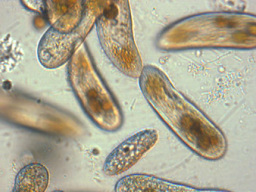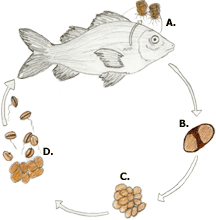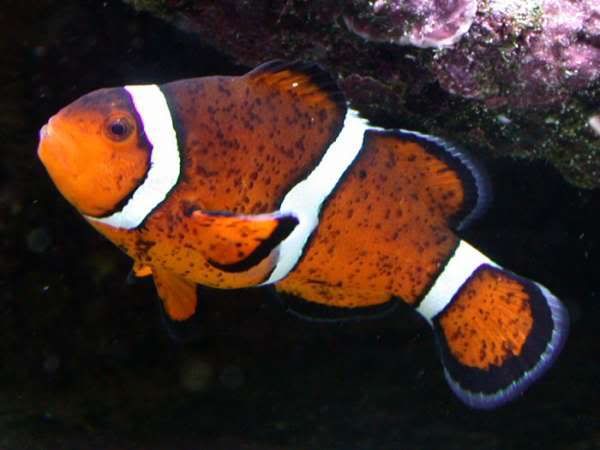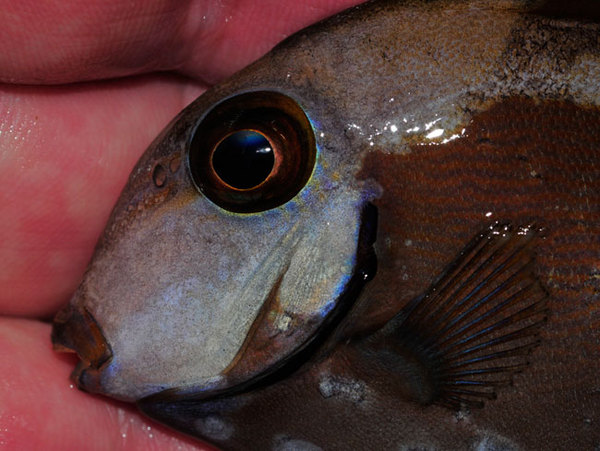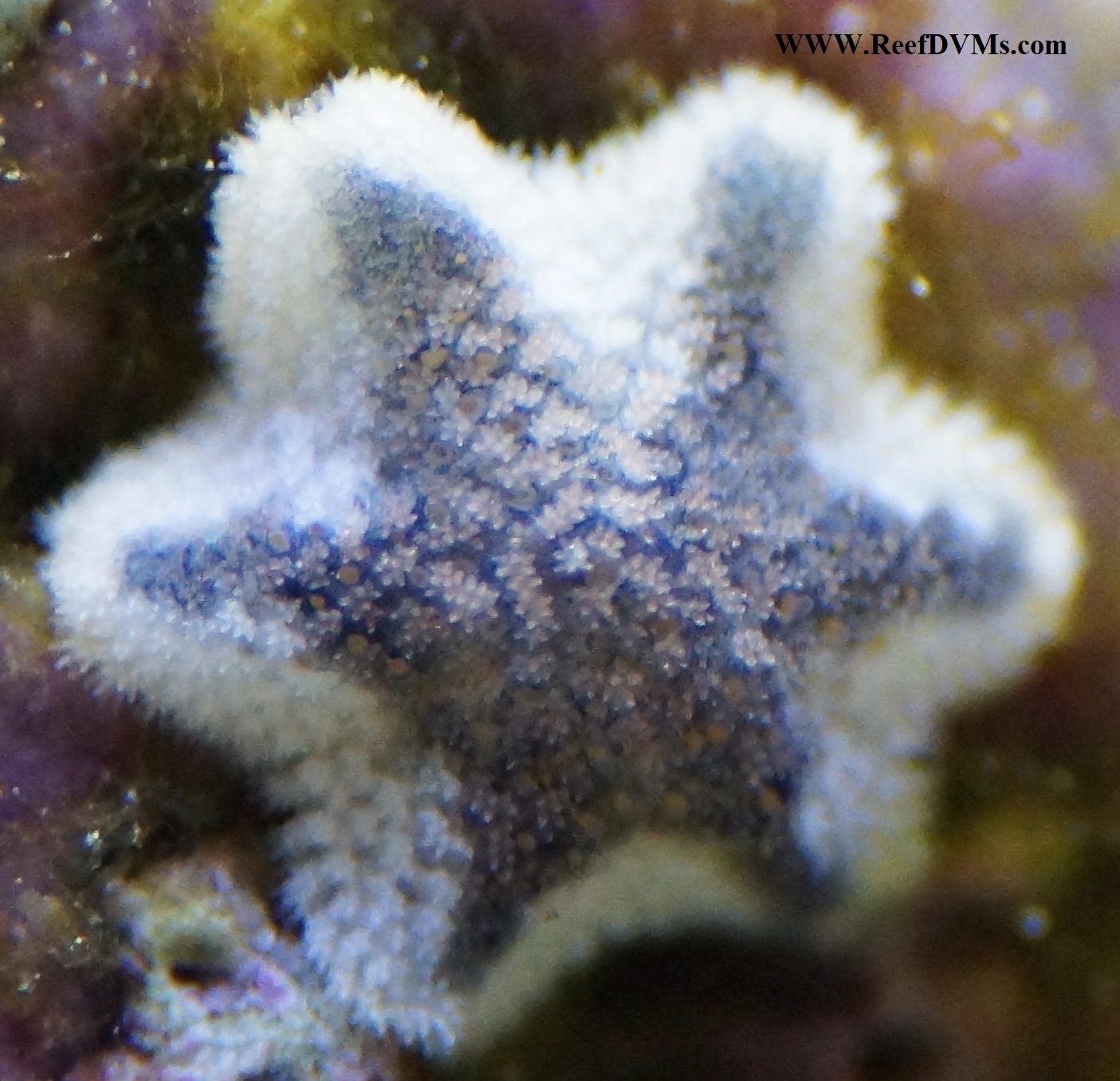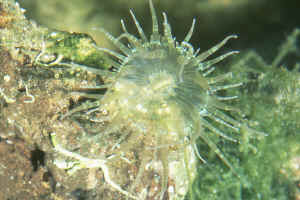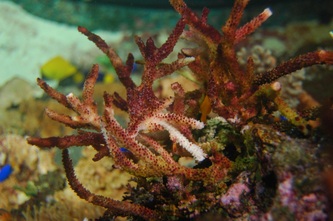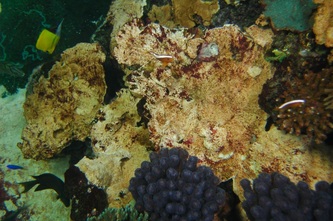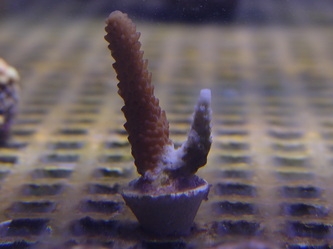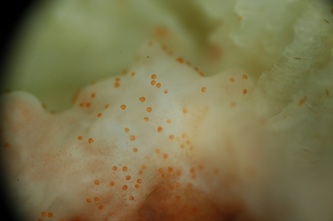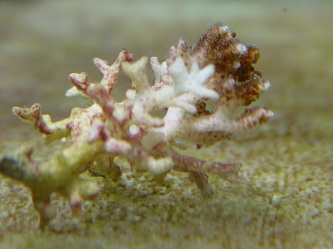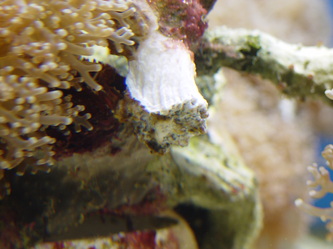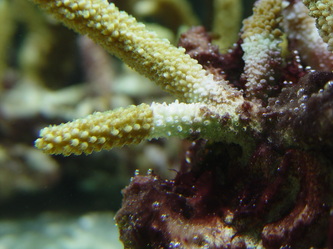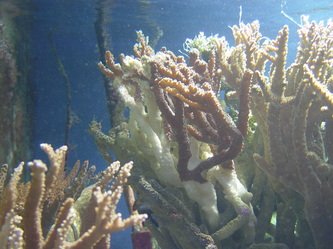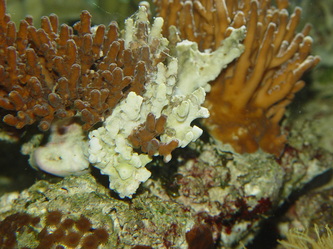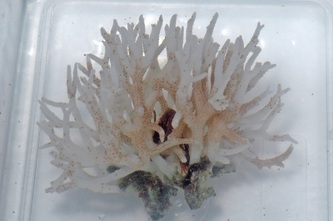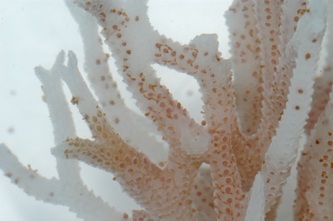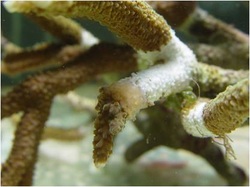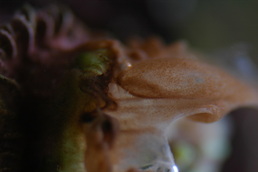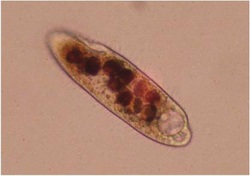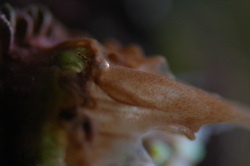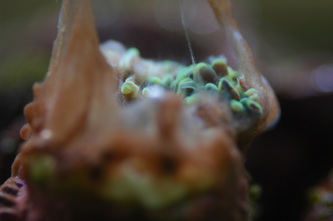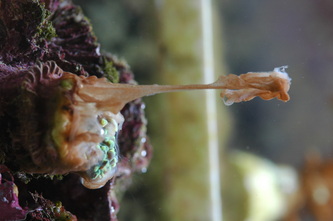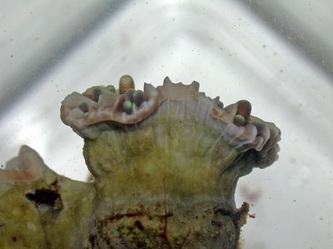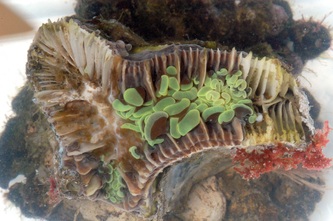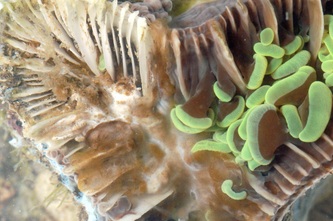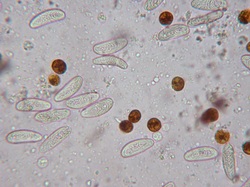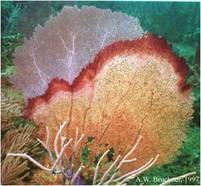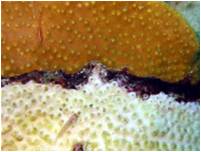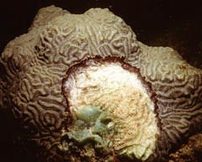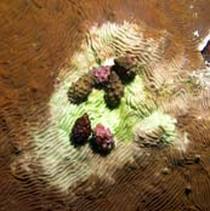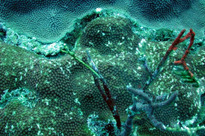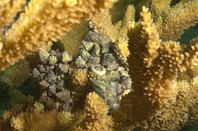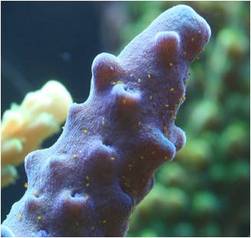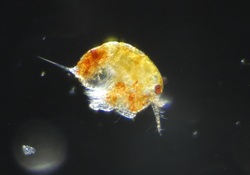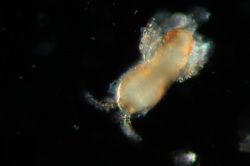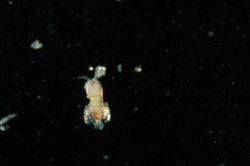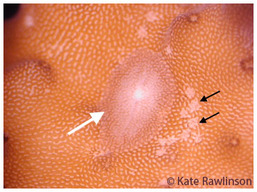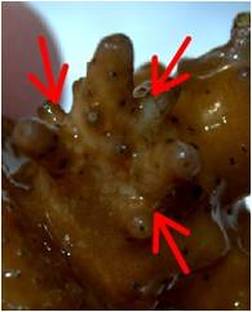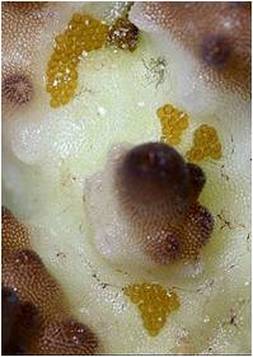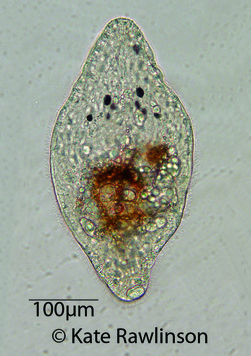Saltwater Tangs showing small black spots on their sides.
Get a cleaner shrimp and keep your water parameters in line. Ammonia or
nitrites high? Shame on you. Your tank isn't cycled and you have a
whole mess of issues ahead. Wait until the tank has cycled before adding
fish. High nitrates? Vacuum the sand and clean out the filters, empty
protein skimmer more frequently. Also give those tangs more seaweed in
their diet.
Saltwater Ich, Cryptocaryon Irritans, Marine Whitespot Disease
Flicking and scratching against rocks
and other surfaces, small white spots resembling sugar covering fins and body. Small black dots (larvae) appear on the sides and fins of affected fish. They may have rapid breathing and stop feeding. Affected fish will scratch themselves on surfaces and swim erratically. They may also breathe abnormally and lose their appetite.
This disease is highly infectious
and can spread rapidly to other fish in the tank. Rapid treatment is highly
recommended. If treated in a reasonable amount of time it is usually not fatal.
If the infestation is minor, a
5-minute freshwater bath may prove effective. Discontinue the freshwater bath
if the fish begins to become overly stressed. For more major infestations, use
copper-based medications to kill the cryptocaryon parasites. In a reef tank
environment, the infected fish must be moved to a hospital tank for treatment.
Never add copper compounds to an aquarium containing invertebrates. Some new
treatments have appeared on the market recently that claim to control parasites
in the marine aquarium. Consult your local aquarium dealer for more
information.
Insure good water quality and
temperature parameters to prevent animals from getting stressed. Stress breaks
down the protective mucous coating on a fish and allows parasites to gain a
foothold. Additionally, any new fish should be given a short freshwater bath
and kept in a quarantine tank for two to three weeks before being introduced
into the main aquarium. The use of an ultraviolet sterilizer has also been
shown to help prevent outbreaks of this disease.
Cause: Planarian;
Ichthyophaga sp., Paravortex sp.
Description
Flukes can infect fish by attaching to the gills or body wall and sucking blood or body fluids. Hooks generally attach the parasite to the host. Those flukes that are monogenetic are able to reproduce in an aquarium and become a problem. Larvae are free swimming and find a host to which they attach. Adults are able to crawl from host to host - they are unable to swim. If a fish knocks them off they will likely die because they must crawl to another host.
At least 2 genera,
Paravortex or
Ichthyophaga, can cause tang turbellarian, a fairly common disease. The larvae appear as tiny black dots on the surface of a brightly colored fish, feeding on the blood of their host. The worm releases from the host and falls to the tank bottom to become an adult, which reproduces to make free-swimming worms that find new hosts. Repeated cycles of reproduction can produce heavily infected fish.
Treatment: As the flukes are dislodged by treatment, care must be taken to avoid knocking them off in the main aquarium which may allow them to reach another host. Treatment should be done in a hospital tank:
- Freshwater baths, with formalin and malachite green. Parasites will fall off and should be destroyed.
- Praziquantel: 1-5 mg/L hospital tank.
- Trichlorfon (Dylox®) 1.0 mg/L daily for 3 days.
Drug Details For The Treatment of Tang Turbellarian, Black Ich, Black Spot Disease:
| Name | Dosage | Action | Precaution | Dangers |
| Formalin | 37% stock, .03 ml/L prolonged; 0.125 - 0.25 ml/L for brief dips | enzyme and cell membrane protein disruption | toxic to fish and humans | algae, invertebrates, fish above 80°F |
| Malachite green | 2 mg/l brief dip, 0.1 mg/L continuous | binds and denatures intracellular proteins | carcinogenic, toxic | poisonous to fish |
| Freshwater Dip | equalize pH, temperature, 5 minute limit | causes osmotic imbalance that leads to plasmolysis - rupture of the cell | toxic procedure, difficult to move and handle sick fish without harming them further | not used on fish with open wounds |
| Praziquantel | 1 mg/L/3-5 days aqueous; 2.5 mg/1 g food orally | either causes calcium imbalance and parasite paralysis or prevents parasite purine sysnthesis | must be used in a hosptital tank | kills some invertebrates, such as feather duster worms |
Saltwater Ich, Coral Fish Disease,
Oodinium, Amyloodinium Ocellatum
Flicking and scratching against rocks
and other surfaces, rapid breathing, tiny white spots covering the body that
give it a white velvet appearance.
This is without a doubt the most
infectious and deadly marine fish disease. The tiny parasites multiply quickly
and eventually move into the gill plates of the fish causing slow suffocation.
It can easily spread to other fish in the tank. If not treated immediately, it
can cause death in only a few days. Rapid treatment is mandatory for the
survival of the fish.
Use copper-based medications to kill
the amyloodinium parasites. In a reef tank environment, the infected fish must
be moved to a hospital tank for treatment. Never add copper compounds to an
aquarium containing invertebrates. Some new treatments have appeared on the
market recently that claim to control parasites in the marine aquarium. Consult
your local aquarium dealer for more information.
Insure good water quality and
temperature parameters to prevent animals from getting stressed. Stress breaks
down the protective mucous coating on a fish and allows parasites to gain a
foothold. Additionally, any new fish should be given a short freshwater bath
and kept in a quarantine tank for two to three weeks before being introduced
into the main aquarium. The use of an ultraviolet sterilizer has also been
shown to help prevent outbreaks of this disease.
Flicking and scratching against rocks
and other surfaces, small black spots on the body.
This disease is caused by small
parasitic worms. The black spots are usually not as numerous as those in white
spot disease. Also, black spot disease is not nearly as deadly.
If the infestation is minor, a
5-minute freshwater bath may prove effective. Discontinue the freshwater bath
if the fish begins to become overly stressed. For worse cases, use a copper or
trichlorofon based solution. In a reef tank environment, the infected fish must
be moved to a hospital tank for treatment. Never add copper compounds to an
aquarium containing invertebrates. Some new treatments have appeared on the
market recently that claim to control parasites in the marine aquarium. Consult
your local aquarium dealer for more information.
Insure good water quality and
temperature parameters to prevent animals from getting stressed. Stress breaks
down the protective mucous coating on a fish and allows parasites to gain a
foothold. Additionally, any new fish should be given a short freshwater bath
and kept in a quarantine tank for two to three weeks before being introduced
into the main aquarium. The use of an ultraviolet sterilizer has also been
shown to help prevent outbreaks of this disease.
Flicking and scratching against rocks
and other surfaces, rapid breathing, cloudy eyes, white patches on body,
worm-like parasites sometimes visible but not always.
This is another disease that is
highly infectious and can be fatal if not treated quickly. It is caused by
small worm-like parasites. They multiply quickly and can clog the gill of the
fish causing slow suffocation.
A freshwater bath will provide
immediate relief for the fish by killing most of the parasites. A long saltwater
bath with
methylene blue is also helpful. Some new treatments have recently
been introduced. Contact your local aquarium dealer for more information about
these.
Insure good water quality and
temperature parameters to prevent animals from getting stressed. Stress breaks
down the protective mucous coating on a fish and allows parasites to gain a
foothold. Additionally, any new fish should be given a short freshwater bath
and kept in a quarantine tank for two to three weeks before being introduced
into the main aquarium. The use of an
ultraviolet sterilizer (UV Sterilizer) has also been
shown to help prevent outbreaks of this disease.
Virus and Bacterial Infections
Erosion of fins and fin rays, reddened
areas, lethargy, poor appetite.
This disease is usually associated
with stress, sometimes brought on by poor water quality. Healthy animals can
usually resist infections. Finrot usually begins as a mild external infection
causing a reddening of the base of the fins. In severe cases, the animal's body
and mouth may be eaten away.
Identify the source of stress and
correct the problem. If this does not correct the problem, the animal should be
treated with antibiotics or Melafix in a hospital tank. Adding antibiotics to the main
aquarium can kill invertebrates and damage the biological filter. Melafix for maar20ine environments are usually always reef safe but look for it stating that on the bottle. Follow the instructions.
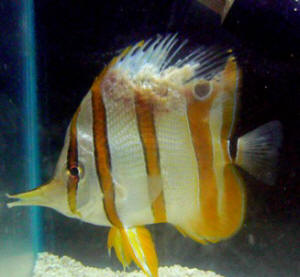 |
| Marine Fin Rot Bacterial |
Insure good water quality and
temperature parameters to prevent animals from getting stressed. Stress breaks
down the protective mucous coating on a fish and allows bacteria to gain a
foothold. The use of an ultraviolet sterilizer may help prevent outbreaks of
this disease.
Pseudomonas,Vibrio
Reddened, frayed fins with open sores,
rapid respiration, cloudy eyes, poor appetite, lethargy, weight loss, abdominal
swelling.
This disease is usually associated
with stress, sometimes brought on by poor water.
quality. Healthy animals can
usually resist infections.
Identify the source of stress and
correct the problem. If this does not correct the problem, the animal should be
treated with antibiotics in a hospital tank. I prefer to use
Melafix by adding antibiotics to the main
aquarium it is invert and reef safe.
Insure good water quality and
temperature parameters to prevent animals from getting stressed. Stress breaks
down the protective mucous coating on a fish and allows bacteria to gain a
foothold. The use of an ultraviolet sterilizer may help prevent outbreaks of
this disease.
Cauliflower Disease
Small warty clumps on the fins that
resemble small cauliflowers.
This disease is caused by a virus
and often looks worse than it is. It is rarely fatal and will usually clear up
on its own if optimum water quality is maintained.
There is no effective treatment for
this disease. A short freshwater dip may help. Maintain optimum water quality
and symptoms should improve with time. If a secondary bacterial infection
should occur, move the animal to a hospital tank and treat with antibiotics.
Insure good water quality and
temperature parameters to prevent animals from getting stressed. Stress breaks
down the protective mucous coating on a fish and allows the virus to gain a
foothold. Additionally, any new fish should be given a short freshwater bath
and kept in a quarantine tank for two to three weeks before being introduced
into the main aquarium.
Other Aquarium Diseases
Ichthyophonus, CNS Disease
Darkening in color, sandpaper
appearance of skin, poor appetite, listlessness.
Fungal spores are present in all aquariums but, if you are not careful, they can become a problem in the saltwater tank.
When cultivating a saltwater aquarium there are a variety of elements you must monitor and control. In addition to keeping your water quality high and your salinity levels stable, you also have to be on the lookout for harmful bacteria and fungus entering the tank. While most aquariums naturally contain some fungus and bacteria, if these organisms are allowed to grow out of control they could contribute to a number of problems in your tank. Filamentous fungus, for example, can be a serious problem in the marine tank. Other forms of fungus may include fungal infections which affect the bodies of fish and egg fungus which can quickly kill fish eggs. To prevent fungus from causing problems in your saltwater aquarium, take the time to learn the basics about how these infections start and what you can do to prevent them.
What is Marine Fungus?
Live marine fungus typically consists of a mass of threadlike filaments called hyphae that grow together in clumps to form mats. Certain types of fungus grow downward into the organic matter on which they are feeding, acting much like the roots of live plants. Other types of fungus grow outward, spreading in the form of fluffy growths. As the fungus grows and spreads, sporangia will form on the tips of the filaments – these sporangia contain spores which will be released into the tank water when the sporangia mature and rupture. Fungus feeds on all kinds of organic matter – fish waste is one the most common foods that they ingest, along with uneaten fish food. Certain types of fungus also exhibit parasitic qualities, feeding on the bodies of fish that have already been damaged by stress, injury or disease.
Marine Fungal Infections
There are several different types of marine fungus, some of which are normally harmless to aquarium fish. Saprolegnia fungi, for example, are common in all types of aquariums and they typically feed on organic waste like dead fish and uneaten fish food. In cases of poor water quality, however, this fungus may start to grow on aquarium fish, especially if its gills or skin have already been damaged. Overcrowding and stress in the saltwater aquarium may also increase the likelihood that normally harmless fungus will begin to attack your fish.
The most common type of fungal infection in saltwater and freshwater aquarium sis body fungus – this type of infection is very distinctive and generally easy to diagnose. These fungal infections typically manifest in the form of fuzzy patches growing on the body or fins of infected fish. As the infection spreads, the growths may become enlarged and could begin to take on a green or brownish tint as a result of debris particles becoming trapped on the filaments. Once this type of fungal infection sets in, it can quickly spread throughout the body of infected fish. Though the infection usually does not penetrate any deeper than the superficial muscle and gill layers of the body, it can cause severe damage. Some fungus may also excrete harmful chemicals that can weaken the immune systems of infected fish, leaving them more susceptible to secondary infections.
Treatment Options
The key to dealing with marine fungus in the saltwater aquarium is to take action as soon as you recognize the problem. While you may be tempted to tackle the infection itself first, your first step should be to remedy the underlying cause of the infection. In many cases, fungal infections are precipitated by a drop in water quality or an increase in stress. Test the water in your aquarium to make sure the water parameters are in line and make adjustments if necessary. If you are able to determine that water quality is not the issue, look for other sources of stress in the tank. If one or more of your fish are particularly aggressive, it could cause the rest of your fish to become stressed. Physical injury as a result of aggressive tank mates or unsafe aquarium decorations may also be a problem.
After you have determined and remedied the underlying cause of the fungal infection you can move on to treating the infection itself. You will not be able to completely remove the fungal spores from your aquarium because they are resistant to treatment. Fortunately, it is unnecessary to remove all of the spores from the tank because they will not harm your fish unless they are already weakened by stress or injury. To deal with fungal infections you should quarantine the affected fish in a hospital tank and treat the water with an anti-fungal medication like Pimafix. There are many anti-fungal medications available including malachite green and formalin – salt may also be an effective treatment for some fungal infections. When treating your fish, make sure to remove any activated carbon from your aquarium filter and follow the dosing instructions carefully. If the infection is particularly stubborn, you may need to use potassium permanganate – this product can be toxic in water with a high pH, so use this product very carefully.
Treatment for this disease is difficult.
Improve the environment and remove any possible causes of stress. Try a
proprietary anti-fungal medication in a hospital tank. Food soaked in
phenoxetol can also be effective if the fish is eating.
The best way to deal with fungus in the saltwater aquarium is to maintain high water qualityso it does not become a problem. Remember, fungal spores are present in all aquariums and they are generally not harmful to fish under normal conditions. If the water quality in your tank drops, however, or your fish become stressed you may have problems with fungal infections.
Prevention: Insure good water quality and
temperature parameters to prevent animals from getting stressed. Stress breaks
down the protective mucous coating on a fish and allows the fungus to gain a
foothold. Additionally, any new fish should be given a short freshwater bath
and kept in a quarantine tank for two to three weeks before being introduced
into the main aquarium.
HLLE
Erosion of the lateral line and the
formation of pits in the skin.
This disease is usually caused by
poor environmental conditions and poor water quality. If conditions are not
improved, the condition of the fish will slowly deteriorate and the animal may
die.
Improve environmental conditions,
maintain optimum water quality and proper diet. The use of vitamin supplements
may help.
Insure good water quality and
temperature parameters. Maintain healthy diet.
None
Erratic behavior, darting around the
tank, rapid breathing, gasping at surface.
This condition can be caused by the
introduction or overdosing of medications, heavy metals, chlorine or
chloramine, household chemicals, or other toxic substances. Immediate action is
required to prevent poisoning or permanent damage.
Remove the pollutants from the tank
through water changes and the use of filter media such as activated carbon. If
the condition is critical, move the animals to a tank with clean water.
Maintain proper water quality and try
to prevent the addition of external toxins. A cover for the aquarium may help.
Follow instructions carefully when using medications.
Poor Diet
Tendency to bloat after feeding, sunken
stomach, thinness, listlessness, loss of color.
The symptoms of malnutrition can be
similar to other diseases.
Provide a good, varied diet. Use the
right kinds of food for each animal. Use of vitamin supplements may also be
helpful in recovery.
Insure proper feeding and proper
diet. Avoid overfeeding.
Aquarium Pests
Fuzzy brown patches on the glass of the
aquarium that eventually spread to the rocks, sand, and decorations.
Brown algae is a common occurrence
in newly set up aquariums. It is not really an algae. It is actually a colony
of microscopic creatures called diatoms. Brown algae is usually caused by
excess silicates and nitrates in the water. It can also be caused by inadequate
lighting. Silicates can be introduced into the water through of tap water.
Avoid using tap water if possible. Silicates can also leech from some
substrates. Avoid using colored gravel from the pet store. Using aragonite sand
or crushed coral as a substrate will help reduce silicate levels.
Wipe the glass regularly with a good
quality aquarium scraper. Magnetic scrapers are available that will let you
clean the glass without having to get your hands wet. Brown algae is commonly
caused by excess silicates and nitrates in the water.
Check nitrate levels and
perform regular water changes with pure quality water.
Brown algae usually goes away after a
new aquarium becomes established. If you continue to have problems, make sure
to perform regular water changes once or twice per month. Regular water changes
are the best way to control algae. If you don't have one, install a good quality
protein skimmer to remove organic waste. You can also install a phosphate
reactor to remove phosphates from the water. Make sure to use pure water.
Consider investing in an RO/DI water filtration system. Also, make sure you are
using lights that are made for aquarium use. Make sure the bulbs are not too
old. Fluorescent bulbs should be replaced every 12 - 18 months. After that, the
wavelength of the light changes and can encourage algae growth. Make sure you
are not leaving the lights on for more than ten hours each day.
Long strands of green algae that
resemble hair growing on the rocks, decorations, or filters.
Hair algae gets its name from its
appearance. It resembles green hair growing in the aquarium. It is caused by an
excess of nitrates and phosphates in the water. Once established, hair algae
can spread quickly and can completely overcome the tank if not properly treated.
Test your water for phosphates and
nitrates. If phosphates are high, you can get find a variety of phosphate
filter media at your local aquarium store. Follow the directions closely. Do
not leave the filter in the water for longer than the suggested use. If left in
too long, the filter can actually leak phosphates back into the water. If
nitrates are high, perform regular water changes with good quality water. Do
not use tap water.
Hair can be controlled by maintaining
good water quality. Make sure to perform regular water changes once or twice
per month. If you don't have one, install a good quality protein skimmer to
remove organic waste. You can also install a phosphate reactor to remove
phosphates from the water. Make sure to use pure water. Consider investing in
an RO/DI water filtration system. Also, make sure you are using lights that are
made for aquarium use and that the bulbs are not too old. Fluorescent bulbs
should be replaced every 12 - 18 months. After that, the wavelength of the
light changes and can encourage algae growth. Make sure you are not leaving the
lights on for more than ten hours each day. You may also want to add some
herbivores to your tank. Blue-legged hermit crabs, sally lightfoot crabs,
tangs, and turbo snails make good choices for controlling algae. If your
aquarium is set up for invertebrates, you will want to keep several
hermitcrabs and turbo snails as part of your "clean-up crew". You may also
want to consider using live sand in your aquarium. Live sand contains
microorganisms that can help to remove nitrates from the water.
Dark green, black, or red bubbles that
look like they are made of plastic are attached to the rocks and sometimes on
the glass and filters.
This is actually a form of algae.
The bubbles, also known as vesicles, are small bladders that contain water.
These vesicles also contain spores. When the vesicle grows large enough, it
will pop and release thousands of spores which will travel around the aquarium
to form new vesicles. Bubble algae of a number of different species with
slightly different shapes and colors, but they all pretty much have the same
characteristics. Bubble algae is notoriously hard to eliminate once it gets
established.
The first step for treatment is to
manually remove as much of the algae as possible. Carefully remove the bubbles
using a sharp instrument such as a sharpened screwdriver or razor blade. Be
careful not to pop the bubbles as this can actually help the algae spread. Part
two of the treatment involves the use of herbivores.
Emerald crabs can be
particularly useful eliminating bubble algae and preventing its return.
Hermitcrabs and sally lightfoot crabs can also be useful. It has been reported that
some red-leg hermit crab species will also eat bubble algae.
Prevention of bubble algae is pretty
much the same as for all algae. You must reduce the algae's food supply by
removing nutrients from the water. A really good protein skimmer is a good
investment for any serious aquarist. A
phosphate reactor can also help to
remove excess nutrients from the water. Regular water changes are also
necessary if you want to prevent algae from growing. Make sure to use pure
water. Consider investing in an RO/DI water filtration system.
Dark red or brown algae that covers the
rocks and sand, resembling velvet. It has a slimy texture and will sometimes be
seen with small air bubbles on it. Slime algae tends to peel off in large slimy
sheets.
This is not actually an algae at all.
It is a form of bacteria known as cyanobacteria. It is one of the oldest forms
of life on earth and may represent an evolutionary link between bacteria and
algae. It may start out in small patches and slowly spread throughout the
aquarium.
Commercial antibiotic treatments for
slime algae are available at your local aquarium store. They vary slightly from
one brand to the next, so make sure you read the instructions thoroughly and
follow the directions exactly. Improper use of antibiotics can affect the
beneficial bacteria that filter the water. Monitor ammonia and nitrite levels
after use to make sure your biological filtration has not been damaged. Most of
these treatments are safe for use in a reef aquarium as long as you follow the
directions exactly. When used properly, these treatments are effective for
controlling slime algae outbreaks.
Slime algae is usually caused by high
levels of nutrients and organic waste in the water. Make sure to perform
regular water changes once or twice per month. Regular water changes are the
best way to control algae. If you don't have one, install a good quality
protein skimmer to remove organic waste. You can also install a
phosphatereactor to remove phosphates from the water.
Tiny, white, gray, or green spotted
starfish all over the rocks and aquarium glass. They are no larger than your
pinky thumbnail and will be seen to have between two and five legs of varying
lengths.
These starfish are known as
asterina. They are an invasive species that is commonly added to the aquarium
as a hitchhiker on live rock or coral when it is added to the aquarium. The
starfish multiply by breaking off their legs. Each leg that breaks off will
grow into a new starfish in a matter of days. Once introduced, asterina can
quickly overcome a reef tank and can decimate your coral. There is some debate
within the aquarium community as to whether asterina will eat coral. There is a large debate on these little guys. I have some and they are not a problem. Others say they can eat your zoas and corals. I have never personally seen that. It started out with just a few
starfish and then within months there were literally thousands of them. I recently
had an outbreak in my aquarium and within a few months all of my zoanthids had
completely disappeared. I also lost a torch coral. They even removed nearly all
of the coralline algae from my live rock.
The only effective treatment for an
asterina invasion is control by means of the harlequin shrimp. The diet of the
harlequin shrimp consists solely of starfish. I added two harlequin shrimp to
my reef aquarium and within six months the asterina were gone. But remember when the starfish are gone they are starving. you might want to lend this animal around or trade out at your LFS. If you have any other starfish in your aquarium, you will have to
remove them before adding the harlequin shrimp. They will eat every starfish
they can find.
Since asterina are introduced to the
aquarium as hitchhikers, the only known prevention method is to thoroughly
examine every piece of coral or live rock before introducing it to your
aquarium. Remove any asterina stars you may see in your tank before they
multiply to biblical proportions.
Small, clear to pink anemones growing
on the rocks and/or glass in the aquarium. The have a circular disk and long pointy tentacles.
Aiptasia are one of the banes of the
marine reef aquarium hobbyist. They are an invasive species that is commonly
added to the aquarium as a hitchhiker on live rock or coral when it is added to
the aquarium. They multiply quickly and can take over a reef aquarium if not
treated. They can sting fish and damage corals. Larger anemones have even been
known to catch and eat smaller fish.
When treatment of aiptasia you have
two choices: chemical or biological. Chemical treatments are commercially
available that can work quite well if you are persistent. They are marketed under
names like Joe's Juice or Aiptasia X. I have had good results with Aiptasia X. The only thing is that you have to insert the tip of the syringe directly into the mouth of the anemone in order to kill it or it will just spread. This can be challenging and may take a few times to actually succeed in accomplishing that. These products are applies directly to the anemone using a small syringe.
Within minutes the anemone will shrivel and implode. The only problem with
these products is that the anemone will grow back, so you have to be diligent
and keep using it until they are gone. The products are safe for use in a reef
aquarium. A biological treatment is also available in the form of a fish. The
aiptasia eating
filefish, or matted filefish (Acreichthys tomentosus) will eat
the anemones and can completely clean out a serious infestation in a matter of
months. I personally keep the
copperbanded butterfly fish. It might take a little time to get them to eat it but when they do your tank will be aiptasia free. I would suggest going with the Aiptasia X for small infestations and
the filefish or copperbanded butterfly fish for large infestations.
Since aiptasia are introduced to the
aquarium as hitchhikers, the only known prevention method is to thoroughly
examine every piece of coral or live rock before introducing it to your
aquarium. Treat any aiptasia with Aiptasia X or similar remedies as soon as you
see them to prevent them from spreading and becoming a problem.
Coral Diseases and Syndromes
Reports
of coral disease are increasing in the wild and have often been linked
to changes in the climate, specifically rise in sea temperatures. In
aquarium systems diseases are also a major cause of concern and often
result in mortality. Small coral frags can often die overnight and there
is not usually much chance of a remedy. However in cases with reef
tanks containing larger colonies, diseases can take longer to take
effect and many blog sites report attempts at curing these diseases,
from fragmentation, quarantine, administration of antibiotics or
commercial products aimed at specific diseases. Here we report the main
diseases commonly associated with aquarium diseases and suggest
potential causes and likely ways to manage or mitigate them.
White Syndrome
Background:
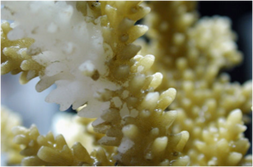
White Syndrome (WS) is a collective term for coral disease lesions showing a sharp demarcation
between apparently healthy coral tissue and the bare coral skeleton,
where the tissues have been removed rather than becoming pale or
'bleached'. You often need to look very close (sometimes with the aid of
a magnifying glass) to distinguish between the two and tell whether
there are any coral tissues still covering the skeleton. This disease,
if left alone, will often result in total colony mortality, with the
lesion advancing more quickly as it progresses to the last remaining
fragments of live tissues. WS has been reported worldwide in the wild
and in aquaria. WS displays variable rates of lesion progression and
patterns of tissue loss, which has led to numerous alternative
descriptions and definitions. The two most commonly referred to with
regard to aquarium corals are: Rapid Tissue Necrosis and Shut Down
Reaction.
Causes:
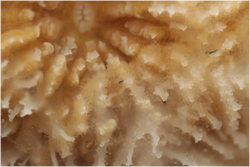
Most
scientific papers and blog sites will accredit this disease to bacteria
of the genus Vibrio. However, it is not clear whether these are primary
pathogens causing the disease or secondary colonisers invading the
tissue once other microbes have caused damage. Relatively high
abundances of Vibrio species live in healthy coral tissue and
environmental samples such as aquarium sand. Recent research (Sweet
& Bythell 2012) has shown the presence of protozoan's known as
ciliates in corals showing signs of WS, and these ciliates can be seen
to ingest the coral's endosymbiotic algae (zooxanthellae), suggesting an
active role in WS pathogenesis. So the actual microbial agent
responsible for WS has not been satisfactorily identified, and there may
be several agents working in parallel.
Management or Mitigation:
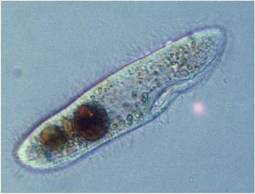
Fragmentation
of the coral at least 1 cm above the disease lesion is currently the
best method to save parts of colonies affected by this disease. Other
treatments such as freshwater dips (15ppt), iodine dips (use 40 drops
per 4.5 litres and immerse coral for 10-15 min), sealing of the disease
lesion with marine putty and antibiotics and/or natural extracts such as
tea tree oil have been shown by a few to succeed. However it likely
depends on the size of your colony and how quickly you catch it - corals
that are already immunosuppressed will often not reposnd well to
further treatments. Isolation of any samples showing this disease will
stop the spread to other corals. However, the underlying cause of the
disease is usually a physiological stress, so always check and adjust
aquarium water parameters when needed if WS develops.
